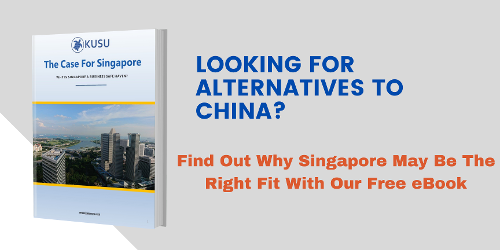The US-China Trade War and the COVID-19 pandemic have made it abundantly clear to many that...
Making Sense Of Trade Tariffs In Manufacturing
Uncertainty, confusion, and volatility have characterized the global economy following the onset of the Covid-19 Pandemic, with new variants, limited vaccination, and new lockdowns further exacerbating economic conditions. Unfortunately, the US-China Trade War and the tit-for-tat tariffs put in place have created additional difficulties for manufacturing companies and their suppliers.
This article seeks to offer companies a straightforward explanation of trade tariffs and help customers in their sourcing decision making process.
The first section will cover some background information, the second section the foundations of current tariff regimes, and the last section will cover current, relevant tariff regimes - or lack thereof.
Background and Definitions
“A tariff or duty (the words are used interchangeably) is a tax levied by governments on the value including freight and insurance of imported products.” This is the most basic definition of “tariffs” according to the US International Trade Administration. The UK Institute for Government adds that tariffs are typically set as a percentage of the determined value of goods. These types of tariffs are known as “Ad Valorem Tariffs. Agricultural tariffs, on the other hand, are usually set relative to weight or per-kilo. These types of tariffs are known as “Unit Tariffs,” says Professor Batabyal in the Conversation. All these different types of tariffs, nevertheless, must nowadays meet the WTO’s “Most-Favored Nation Tariffs” (most restrictive as a whole) requirements or “Bound Tariff” (a price spectrum-type tariff for specific goods) requirements unless tariffs are “Preferential Tariffs” which are provisions under preferential trade agreements that ensure tariffs are minimal or even virtually zero.
It must be noted that the national customs authority of the country importing the goods (the country bringing in the goods) will collect all these different types of tariffs. Companies must also “pay” for the tariffs by having their goods be sold at a higher price on the foreign market, says the UK Institute for Government. Though, in lieu of direct tariff payments to customs authorities or, perhaps, in addition to direct tariff payments foreign, companies may also need to pay Value Added Taxes, other national sales taxes, other local regional taxes, and/or customs fees. Therefore, it is absolutely imperative companies properly calculate the different fees (tariffs included) companies must pay to national customs authorities (as well as logistics costs such as shipping, freight, and insurance) prior to exporting goods so that companies can adjust the prices of goods accordingly. Evidently a cumbersome process, countries impose tariffs for a number of reasons.
Professor Batabyal in the Conversation states that tariffs are the oldest and perhaps the most directly impactful trade policy instrument at a country’s disposal. This is primarily the purpose tariffs serve in the modern age, in addition to protecting domestic industries from foreign competition. Smaller countries and/or middle-income countries would undertake the latter economic development policy, though high-income countries have also been enacting tariffs to optimize certain industries. Nonetheless, these countries must also take into account just how much the tariffs artificially distort domestic market consumption trends and whether domestic producers can capitalize on the policy. However, historically, tariffs served as the main means for a country and its government to raise revenue, especially in the 18th century before the 16th Amendment in 1913 established the income tax system in the US.
Evidently, tariffs and tariff regimes are highly complex, web-like, and precise matters that require incredibly diligent and sophisticated internal company processes so as to ensure all the different requirements laid out under the different tariff are met. Hence, the World Trade Organization (WTO) was established to simplify existing international tariff regimes following World War Two, promote global trade, and reduce tariffs to better promote global trade. According to the WTO itself, the following was how the WTO came to be. “This first round of [trade] negotiations resulted in a package of trade rules and 45,000 tariff concessions affecting $10 billion of trade, about one fifth of the world’s total. The group [of nations] had expanded to 23 by the time the deal was signed on 30 October 1947. The tariff concessions came into effect by 30 June 1948 through a “Protocol of Provisional Application”.
And so the new General Agreement on Tariffs and Trade [the precursor to the WTO] was born, with 23 founding members (officially ‘contracting parties’).” Admittedly, the GATT was only supposed to be a stopgap agreement/multilateral framework governing international trade, with the International Trade Organization meant to be the ultimate multilateral framework. It eventually fell through due to domestic challenges in ratifying the agreement, even in the US despite the US being the main proponent of the agreement/multilateral framework. New amendments and sub-agreements were made periodically (typically every decade).
These periods of time were referred to as rounds and by the time of the Tokyo Round in the mid-to-late 1970s 30% of customs duties in the nine largest industrial markets were eliminated and thus average tariff rates on industrial products were reduced to 4.7% by this point. Tariff reductions imposed at each new round would typically afford all relevant parties a specific amount of time to “harmonize” with the newly established tariff rates. The aforementioned framework essentially persisted until 1995 wherein the GATT was eventually replaced by the new WTO. It ultimately became necessary to revamp the GATT as by the 1980s, the GATT was failing to really meet the challenges of the new international trade system.
For example, it did not have rules or provisions that specifically covered the trade of services, there were numerous loopholes when it came to agricultural tariffs, it did not cover the trade of textiles which were instead government by the Multi Fiber Agreement, and it arguably could not manage the frantic growth of merchandise trade. Following the establishment of the WTO, countries went about quickly to reform the multilateral trading framework and, consequently, the international tariff regimes.
Foundations of Tariff Regimes
According to the WTO, “Developed countries’ tariff cuts were for the most part phased in over five years from 1 January 1995. The result is a 40% cut in their tariffs on industrial products, from an average of 6.3% to 3.8%. The value of imported industrial products that receive duty-free treatment in developed countries will jump from 20% to 44%... On 26 March 1997, 40 countries accounting for more than 92% of world trade in information technology products, agreed to eliminate import duties and other charges on these products by 2000 (by 2005 in a handful of cases). As with other tariff commitments, each participating country is applying its commitments equally to exports from all WTO members (i.e. on a most-favoured-nation basis), even from members that did not make commitments.”
The previously mentioned Multi Fiber Arrangement was eventually replaced by the Agreement on Textiles and Clothing in 1995, states the WTO. By 2005, the Agreement was subsumed into the WTO’s very rules, with quotas (a type of non-tariff barrier that essentially serves similar roles to tariffs in terms of limiting international goods coming in) finally coming to an end and an “even playing field” established in the textiles manufacturing sector which was all done in approximately ten years from the signing of the Agreement. Since the WTO was established, more and more Free Trade Agreements have been agreed upon by states, potentially as a testament to the new international trading system’s greater improvement upon the previous international trading system.
According to the US International Trade Administration, “A Free Trade Agreement (FTA) is an agreement between two or more countries where the countries agree on certain obligations that affect trade in goods and services [including tariffs], and protections for investors and intellectual property rights, among other topics. For the United States, the main goal of trade agreements is to reduce barriers to U.S. exports, protect U.S. interests competing abroad, and enhance the rule of law in the FTA partner country or countries.” In doing so, a more predictable, transparent, and potentially cheaper trading and investment environment is created for the respective countries. These FTAs are becoming increasingly important, especially as production has become more and more integrated into the existing global supply chains. Production is far more specialized than before and goods traverse multiple national borders, reports scholars from the European Union.
This is especially true for companies that produce components. A different article by a different set of European Union scholars states that FTAs (i.e. the greater elimination of tariffs) can directly lead to increases in domestic value-added content of exports through global value chains. In short, exports can become more valuable.
Nonetheless, Regional Trade Agreements (RTAs) also serve a similar purpose to FTAs in that they promote greater international trade and reduced tariffs in service of promoting greater international trade (albeit at the regional level and in a more limited manner as RTAs are meant to create an agreed-upon set of rules for trading among signatory states).
Another tool used a lot to promote greater international trade is the Free Trade Zone (FTZs). UNESCAP states that FTZ are, in essence, entry ports for goods wherein more broadly special custom procedures are permitted in accordance with a specific legislation that deems it such or an international agreement that allows for such seamless trade between countries. These procedures allow for domestic activity of imported goods to occur prior to formal customs entry, says the US International Trade Administration.
Moreover, re-exported items are duty-free/tariff-free whereas items entering the US market, for example, have duty payments deferred. Thus, FTZs have also become a significant trade policy instrument/commercial policy instrument (though, arguably mainly for the greater promotion of export-oriented FDI inflows) and can even help countries attract specific companies through the creation of smaller Free Trade Subzones.
It can be argued, however, that the presence of FTZs can make FTAs redundant assuming FTZs already exist and companies have been making use of them. Therefore, scholars from the European Union stress that companies need to assess the different tariffs, duties, and other customs procedures currently in place in foreign countries they wish to export to so as to ensure they follow any and all trade and tariff regulations put in place by both the relevant FTAs and the FTZs. Larger companies entering a foreign market tend to declare their goods through FTA provisions whereas smaller companies tend to declare their goods through FTZ due to costs associated with Rules of Origin provisions, according to the Economic Research Institute for ASEAN and East Asia.
Current Tariff Regimes
As a whole, according to the Office of the United States Trade Representative, “Approximately 94 percent of U.S. merchandise imports by value are industrial (non-agricultural) goods. The United States currently has a trade-weighted average import tariff rate of 2.0 percent on industrial goods. One-half of all industrial goods imports enter the United States duty free.” In this context, industrial goods refer to the following: machinery, automobiles, transportation equipment, information technologies, minerals and metals, petroleum, chemicals, textiles and clothing, leather and footwear, consumer goods, wood products, and fish and fish products. However, it is likely that although tariffs are stabilising, new rules of origin procedures will be put in place under the new United States-Mexico-Canada Agreement which could mean higher customs fees for automobiles, trucks, and other products (see: Office of the United States Trade Representative).
Other non-tariff barriers such as import licensing and export licensing have been updated (especially when it comes to the textiles and clothing sector). Tariff rates put in place under the USMCA’s predecessor more or less remain the same save for reduced steel and aluminum tariffs imposed by the US under President Trump. On the other hand, a Congressional Research Service report stated that “Average U.S. and EU tariffs are relatively low (trade-weighted average of 2.3% and 3.3%, respectively in 2018), after successive rounds of multilateral trade liberalization. Over 60% of bilateral merchandise flows are duty-free, but ‘tariff peaks’ make sensitive imports more expensive. Additional tariff liberalization could yield economic gains given the magnitude of commercial ties.” Since then, EU negotiating directives released in April 2019 have stated that all industrial products tariffs imposed upon the US will be eliminated going forward.
This was a significant development considering, previously, the EU simply sought to stabilize US-EU trade relations following the US imposing tariffs on the EU (in an attempt to address pre-existing tariffs and non-tariff barriers as a whole). More recently, the 2021 EU-US Summit has seen the EU and the US work together to resolve the Airbus-Boeing WTO dispute through the creation of a Cooperative Framework for Large Civil Aircraft and the five-year suspension of all aviation tariffs. In addition, according to the European Council, the steel and aluminum tariff disputes were officially withdrawn from WTO disputes (though what further progress has been made on the tariffs themselves remain unclear). Nevertheless, a US-EU FTA still has not come to fruition despite the fact that a Canada-EU FTA, Japan-EU FTA, and even a Vietnam-EU FTA already exist, says the same Congressional Research Service report.
The ASEAN Free Trade Area (AFTA) is another highly important multilateral trading framework, though it evidently does not involve the US unlike the USMCA and the EU. In 1992, it created the first Southeast Asian single market, facilitated a more robust international production base, and helped attract greater FDI inflows and expand intra-ASEAN trade. According to the Malaysian Ministry of International Trade and Industry, it was able to spur the latter through the use of the Common Effective Preferential Tariff Scheme which saw the gradual and sectors-based reduction and elimination of intra-regional tariffs, while at the same time respecting the sensitivity of specific sectors to various ASEAN Member States’ domestic industries. Intra-ASEAN tariffs were to be reduced to 0% to 0.5%, though Cambodia, Laos, Myanmar, and Vietnam were granted time to reduce tariffs.
However, the AFTA, unlike the EU, does not set a universally applied external tariff rate. Instead, each ASEAN Member States is allowed to set tariffs themselves. By 2010, Brunei, Indonesia, Malaysia, the Philippines, Singapore, and Thailand have virtually created a free trade area wherein 99% of products traded have had tariffs and import duties eliminated. “Today, the ASEAN-6 has 99.20 per cent of tariff lines in the Inclusion List at 0% import duty. This means that only 0.35 per cent of the tariff lines in the Inclusion list have import duties. For CLMV, 90.90 per cent of the tariff lines in the Inclusion List are already at 0% import duty. Therefore, on the average, ASEAN member states have 96.01 per cent tariff lines at 0% import duty according to the ATIGA Tariff Schedule of 2016.” This is a quote from the Malaysian Ministry of International Trade and Industry.
Conclusion
In conclusion, the US has FTAs with Mexico and Canada though it does not have an FTA with the EU. However, it does have an FTA with approximately twenty other countries. One of these countries, unsurprisingly, includes Singapore which remains the sole Southeast Asian country the US has an FTA with. However, prior to the FTA, Singapore was already allowing US goods to enter the Singapore market essentially duty-free. After the signing of the FTA, all remaining customs duties were eliminated. As a result, the US accelerated its own tariff phase-out schedules so as to allow for the elimination of 92% of all tariffs aimed at Singaporean goods by the time the FTA came into effect in 2003, reports the office of the United States Trade Representative.
Since then, according to a different report by the United States Trade Representative, tariffs for more sensitive goods (e.g. information technology products, infrastructure equipment, scientific instruments, and medical equipment) have also been eliminated. Additionally, a zero-for-zero agreement wherein the two countries would eliminate further tariffs on specific and mutually agreed upon industrial sectors is in place.
Going forward, hopefully the successes of the US-Singapore FTA could lead to new US FTAs with other Southeast Asian countries. Southeast Asia will continue to grow to become a significant manufacturing center and a significant economic center as a whole. The US would be wise to capitalize on this known fact and facilitate greater trade relations with Southeast Asia.
-1.jpg?width=146&height=50&name=Kusu%20(1)-1.jpg)




.png?height=200&name=Untitled%20design%20(7).png)
-1.png?height=200&name=Untitled%20design%20(25)-1.png)